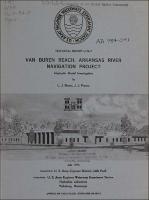Please use this identifier to cite or link to this item:
https://hdl.handle.net/11681/13133| Title: | Van Buren reach, Arkansas River navigation project : hydraulic model investigation |
| Authors: | United States. Army. Corps of Engineers. Little Rock District Shows, Louis J. Franco, John J. |
| Keywords: | Arkansas River Navigation channels Inland navigation Hydraulic models Van Buren Reach Shoaling Sedimentation Sediment transport Navigation conditions |
| Publisher: | Hydraulics Laboratory (U.S.) Engineer Research and Development Center (U.S.) |
| Series/Report no.: | Technical report (U.S. Army Engineer Waterways Experiment Station) ; H-74-7. |
| Description: | Technical Report Abstract: The Van Buren reach of the Arkansas River is in Lock and Dam No. 13 pool near Van Buren Ark., about river mile 353. The reach is characterized by three relatively flat bends and is crossed by three existing or proposed bridges. The location of the navigation spans of the two existing bridges could cause considerable difficulties in navigating the reach and in maintaining a channel of adequate dimensions based on the alignment of the navigation spans. A hydraulic model reproducing about 4 miles of the Arkansas River including the three bridges was constructed to an undistorted scale of 1:120. Originally the model was of the semifixed-bed type for the navigation studies. It was later converted to the movable-bed type and used to determine (A.) the best location for a navigable channel; (B.) the modifications required to the two existing bridges; (C.) adequacy of the proposed structures in the development of a satisfactory channel; and (D.) modifications needed to improve navigation conditions and channel depths through the reach. The investigation revealed the following: (1.) The channel had a natural tendency to develop in a sinuous alignment with the channel crossing first toward the right bank and then back toward the left bank. Following the natural tendency of the river would produce conditions hazardous for navigation, particularly during the higher flows, because of the location of the two existing bridges with respect to the navigation span of the I-540 bridge under construction. (2.) The best alignment for the channel insofar as navigation is concerned is along the left or convex side of the bend, eliminating the two crossings. (3.) Development of a channel along the left side would require considerable contraction and training structures to offset the strong tendency toward shoaling along that side. (4.) A system of vane dikes could be developed which would practically eliminate the need for maintenance dredging . |
| Rights: | Approved for public release; distribution is unlimited. |
| URI: | http://hdl.handle.net/11681/13133 |
| Appears in Collections: | Technical Report |
Files in This Item:
| File | Description | Size | Format | |
|---|---|---|---|---|
| TR-HL-74-7.pdf | 8.79 MB | Adobe PDF |  View/Open |